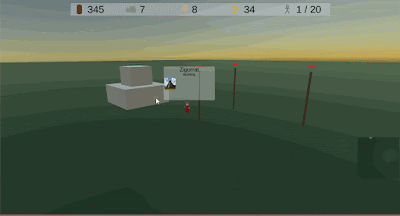This means that I am home quite late and that doesn't afford me much time to work on my game. Holiday is over indeed.
Having said that, I'm glad I was able to lay some groundwork for things I could implement in the hours and half hours of the evening, between dinner and Casa de Papel that me and my wife just started watching.
With the placeholder GUI in placeholder place, the coming time will mostly be about object interaction, about unit AI and the like, but only in following orders. Letting the enemies control their units is for later. For now, I'll be focussing on making sure that when a decision is made, the objects know what to do.
Things I am planning to do soon include:
- Changing a dead object or a dead and resourceless object to look and behave differently. For instance, when you kill a goat, it'll fall over and you can harvest the food. When the food is gone, it looks the same, but you can't interact with it anymore. I want this to be clearer. Maybe turn the goat into a skeleton and have it vanish over time.
- Right now, resources can be dropped at any building. I'd like to change that. You shouldn't be able to drop wood at the barracks. I'll probably build granaries, storage buildings and the like for that.
- When you attack a unit and it runs, following it is very simple. Have the unit close in and if it's close enough, continue attacking. I'd like the attacker to have to face the defender before fighting. Besides, I don't want the following to go infinitely. That could be a tricky thing later when players discover luring enemy units.
- If you gather resources, you return to a building. That works. But if gathering or returning is interrupted, there's no way to just drop the stuff at the building and be done with it. To drop something now, you need to first send the unit to the resource to have it return. I'd like to trigger returning directly.
I don't think that these points are very big, so these should be fine for the evenings. Besides, I really like the small successes that such things make. They are really motivating.

